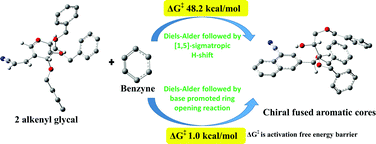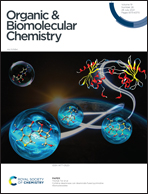The mechanism of conversion of substituted glycals to chiral acenes via Diels–Alder reaction: a computational study†
Abstract
Synthesis of linearly fused aromatic systems using a glycal-based diene with an aryne is a long-standing topic of interest in glycal chemistry. We have examined the mechanistic pathways for the transformation of substituted glycals to chiral fused aromatic cores via Diels–Alder (DA) reaction using the SMDACN-M06-2X/6-31G(d) level of theory. The DA reactions of E (1a) and Z (1a′) forms of C-2 alkenyl glycal and an aryl glycal (1b) as a diene were examined with a benzyne intermediate generated as a dienophile. The computational results reveal that 1a and 1b can only be transformed into the fused aromatic cores by the base-catalyzed reaction because a [1,5] sigmatropic hydrogen shift is not feasible. The activation free energy barrier for the base-catalyzed proton abstraction process is 4.2 kcal mol−1 and there is almost no barrier for stereoisomeric 1a DA-complexes. The activation free energy barrier values for stereoisomeric 1b DA-complexes for the base-catalyzed proton abstraction process are 10.8 and 12.4 kcal mol−1. The appropriate orientation of glycal-ring-oxygen and hydrogen at the 5th position of Z (1a′) forms of C-2 alkenyl glycal facilitates the [1,5] sigmatropic hydrogen shift; however, the base-catalyzed reaction is energetically more favored than the former case. The rate-determining step for 1a and 1a′ is the ring-opening step (18.2 and 19.5 kcal mol−1 for the S-stereoisomer), whereas the DA adduct formation step is the rate-determining step for 1b (16.1 kcal mol−1 for the S-stereoisomer). The structural analysis reveals the formation of the preferred S-stereoisomer over the R-stereoisomer with the respective dienes.

- This article is part of the themed collection: Mechanistic, computational & physical organic chemistry in OBC


 Please wait while we load your content...
Please wait while we load your content...